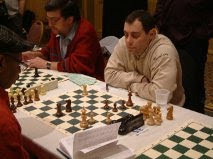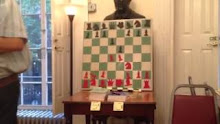Dmytro Kedyk (USCF 2418) - Jim West (USCF 2201)
1.e4 c5 2.Nf3 d6 3.d4 cxd4 4.Nxd4 Nf6 5.Nc3 a6 6.Be3
This variation was first popularized by grandmaster Robert Byrne.
6...e5 7.Nb3 Be7 8.f3 Be6 9.Qd2 O-O 10.O-O-O Nbd7 11.g4 b5 12.g5 Nh5
The black knight looks out of play on h5, but it slows down White's kingside pawn storm and is prepared to occupy f4 at the right moment.
13.Rg1
Instead, the game Byrne-Fischer from the 1971 Manhattan Blitz Tournament saw the sharp continuation 13.Nd5 Bxd5 14.exd5 Rc8 15.Bh3 Rc7 16.Na5 Nb8 17.Bg4 Nf4 18.h4 f5 19.gxf6 Bxf6 20.Bb6 Rxc2+ 21.Qxc2 Qxb6 22.Nc6 Rf7 23.Nxb8 Qxb8 24.Kb1 Rc7 25.Qb3 Ne2 26.Qe3 Nf4 27.Rc1 h5 28.Be6+ Kh7 29.Qe4+ g6 30.Rhg1 Kh6 31.Rc6 Rxc6 32.dxc6 Qb6 33.Rc1 Nxe6 34.Qd5 Nc7 35.Qxd6 Bg7 36.Qe7 Kh7 37.a3 a5 38.Rd1 Qxc6 39.Rd7 Ne6 40.Rd6 Qxf3 41.Qxe6 Qf5+ 42.Ka2 e4 43.Qe7 Kh6 44.Rd7 Qf6 45.Qxf6 Bxf6 46.Rd5 e3 47.Rd3 e2 48.Re3 Bxh4 49.Rxe2 Bg3 50.Kb3 h4 51.a4 bxa4+ 52.Kxa4 h3, White resigns.
13...Rc8
Perhaps I should have followed the game Lukin-Khasanov, USSR 1983 which continued 13...Nb6 14.Kb1 Rb8 15.Nd5 Bxd5 16.exd5 Qc7 17.Rg4 "with a double-edged position", according to Nunn. In this way, I would have overprotected d5 and forced my opponent to recapture on that square with a pawn.
14.Kb1 Nb6 15.Qf2 Nc4 16.Bxc4 Rxc4 17.Nd5 Bxd5 18.Rxd5
18...f5 19.Nd2
White wants more than the position that would arise after 19.gxf6 Nxf6 20.Qg3 Rf7 21.Rdd1 a5 when Black has attacking chances of his own.
19...Rc6 20.exf5 Rxf5 21.Ne4 Nf4 22.Bxf4 Rxf4 23.Rgd1 Qf8
Black has light-square weaknesses which White has exploited successfully by posting his pieces on the central d5 and e4 squares. On the other hand, White's weak f3 pawn is an inviting target.
24...Rxf3 25.Nf6+ Rxf6 26.gxf6 Qxf6
27.R5d2 Rc4 28.Qd3 Qe6 29.Re2 h6 30.b3 Rf4 31.Qe3 Qc8 32.Rf2 Rxf2 33.Qxf2 Qc3
34.Rd3
At this critical juncture, White begins to play inaccurately. The right way to proceed is to force Black to find moves by 34.Qa7 Kf8 35.Qxa6 Qf3 36.Rg1 Qf2 37.Qa8+ Kf7 38.Qd5+ Kf8 39.Rg3 Qe1+ 40.Kb2 b4 41.Rf3+ Bf6 42.Qd6+ Kg8 43.Qe6+ Kh8 44.Qh3 Kh7 45.Qf5+ Kh8 46.Qc8+ Kh7 47.Qc4 e4+ 48.Rxf6 gxf6 49.Qf7+ Kh8 50.Qxf6+ Kh7 with an extra pawn and at least a draw in hand by perpetual check.
34...Qc6 35.Qf5 Qh1+ 36.Kb2 e4 37.Qd5+ Kh8 38.Rd1 Qf3
39...Qf6+ 40.Rd4 Qxd4+! 41.Qxd4 Bf6 42.Kc3 d5 43.a3 Bxd4+
44.Kxd4 g5 45.c4 dxc4 46.bxc4 bxc4 47.Kxc4 Kg7 48.Kd4 Kf6 49.Kxe4 a5 50.a4 h5 51.Kf3 Ke5 52.Ke3 g4
Even though I have not played as accurately as I should, this ending is still a win for me by one tempo.
53.Kf2 Kd4 54.Kg3 Kc4 55.Kh4 Kb4 56.Kxh5 Kxa4 57.Kxg4 Kb3 58.h4 a4 59.h5 a3 60.Kg5 a2 61.Kg6 a1=Q 62.Kh7 Qf6 63.h6 Qg5, White resigns.
{This article originally appeared in the Winter 2004 issue of Atlantic Chess News}




























